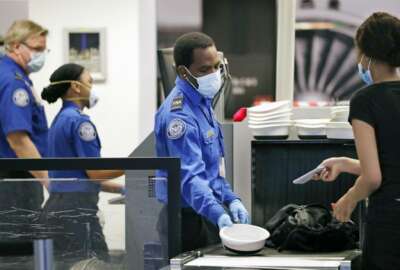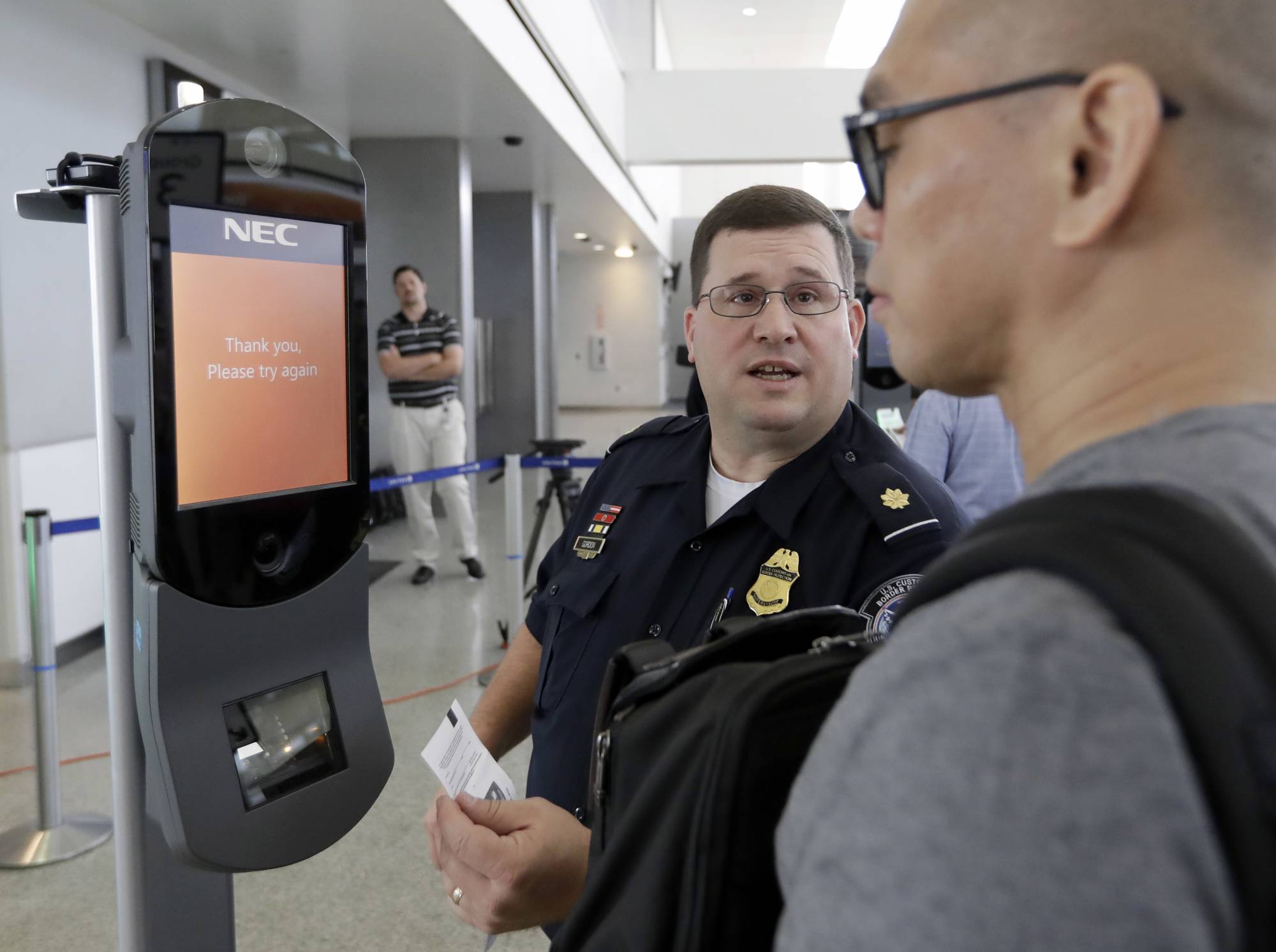Hubbard Radio Washington DC, LLC. All rights reserved. This website is not intended for users located within the European Economic Area.
What goes on at the TSA’s big operations center
Nearly every moment a security issue takes place somewhere in the transportation system. Thousands of incidents each week get reported to the Transportation Sec...
Nearly every moment a security issue takes place somewhere in the transportation system. Thousands of incidents each week get reported to the Transportation Security Administration’s big operations center in Herndon, Virginia. For more of what goes on there, the Federal Drive with Tom Temin spoke with Toby Punchard, supervisory air marshal in charge at the Transportation Security Operations Center.
Interview Transcript:
Tom Temin And tell us about the Transportation Security Operations Center. It’s run by someone in the Air Marshal, which I guess I didn’t realize was actually under TSA. But what happens in this SoC.
Toby Punchard The Transportation Security Operations Center is the U.S. government and TSA’s primary resource for collaborating, communicating, coordinating and managing incidents that affect all modes of transportation. And we are unique because we are the only operations center in the U.S. government doing what we do. We have partners that we work with very frequently, daily and hourly in some cases. Those include the Federal Aviation Administration and the Department of Defense. Primarily, we use some of their resources to help us accomplish our mission, because our mission is so much wider in breadth. But again, we are the only operations center in the government doing what we do coordinating, collaborating, communicating and managing incidents that affect all modes of transportation. And those include maritime pipeline, passenger rail, mass transit and aviation, which is our biggest industry, our biggest stakeholder.
Tom Temin And so then who reports in to that center such that you know what’s going on?
Toby Punchard We look at incident management through two lenses here in the United States. We get information from various sources and resources. Primarily, TSA has federal security directors assigned to specific areas of responsibility around the country. Each of those federal security directors has a coordination center, which is a smaller operation center, and they feed and communicate directly into the TSOC, into our operations center for incidents affecting modes of transportation in their specific areas of responsibility. We also have industry stakeholders. We have memorandums of understanding and security directives requiring certain transportation stakeholders to report incidents that affect transportation to us globally. The second lens, how we manage it globally, we take in information from, again, a number of resources. We have key personnel assigned to areas of responsibility around the world. They’re based in countries around the world, and they provide oversight for transportation security in those areas and in those countries to make sure that those countries aviation security apparatus is up to the United States.
Tom Temin But when you say things that affect transportation, I mean, except for the weather, which can affect an entire region or a continent of transportation, everything else that happens in transportation is local. A door blows off a plane and lands somewhere and landed, and the door is in somebody’s backyard. Or a train rams a tank truck, but it’s a local effect. And so what constitutes something that is worthy of being reported up to you, that requires coordination that everyone else should know what’s going on.
Toby Punchard Most people see the end product of those events. They don’t realize how complicated those events are to manage during the incident, and to get to the outcome that you see reported later in situations where there’s an incident affecting, and we’ll use aviation as an example. And I talk about our partners like the Federal Aviation Administration. When those events are occurring, there’s a lot of communication between the stakeholders are invested in that incident. Again, the Federal Aviation Administration, the stakeholder or the airline that’s involved and the Transportation Security Operations Center, along with all the resources we have in place on the ground at the specific airport that’s going to be affected by the event.
Tom Temin So that could be fire and rescue, potentially. It could be a regional event.
Toby Punchard State, federal and local resources in that area of responsibility for that incident. We’re all in communication to help manage and work through that incident and ultimately recover to normal operations.
Tom Temin Right. So if something was happening that could affect all aviation at Dulles, even though it involved one plane, say a wheel falls off and sometimes they land and the ear doesn’t come down or there’s a wheel crooked, that could affect that runway, potentially. And therefore BWI would need to know, Reagan National would also need to know. Is that a good example of the type of thing?
Toby Punchard Those incidents have ripple effects across the aviation industry. So when something happens at Dulles, it does have a ripple effect across industry. And that’s part of our role. One of our primary roles is the big picture. Keep an eye on the big picture, making sure senior leadership is informed of the ramifications of the incident on the national transportation system, and ultimately informing them so they can make decisions to help recover from the incident as we work through it.
Tom Temin We’re speaking with Toby Punchard. He’s supervisory air marshal in charge of the Transportation Security Operations Center in Herndon, Virginia. And how often a day does something happen that causes incoming information, and therefore compiling and outgoing information from the center?
Toby Punchard I mentioned the various resources we use to take in information. And I’ll give you an example of the workload just in volume of calls. The Transportation Security Operations Center takes in approximately 13,000 calls a month related to incidents affecting transportation. And again, that’s all modes of transportation. We signify around 30 to 40 of those a day as significant meaning these are the ones that should get the attention, these are the ones that have the potential for the most impact. And of those, there’s a triage. And that’s where we talk about incident management of the three different levels that we triage those to determine what kind of resources we want to apply to it.
Tom Temin Right. So there’s more than one an hour basically all the time.
Toby Punchard In terms of volume of reporting that comes into the TSoC. Definitely more than one hour.
Tom Temin And what is the mode that produces the most calls in the year?
Toby Punchard Aviation is our largest stakeholder, the largest industry. And our biggest responsibility that we bear is the aviation industry. Because of the scope of travel, TSA screened more people this year comparatively than ever before. The travel aviation industry is continuously breaking records in way of travel and passenger throughput.
Tom Temin Yeah, I’ve noticed being at an airport. And with respect to the things that TSA screens for the millions of people a year that go by screening operations at the airports, do any of those happenings or findings ever make their way to the level of the security operations center?
Toby Punchard Every day. I mentioned the coordination centers in the specific regions, different regions of the nation that are controlled by the federal security directors. They have standards reporting standards to the Transportation Security Operations Center. Any time there’s, for instance, a weapon discovered at a checkpoint that triggers a notification to the Transportation Security Operations Center, and we can monitor that incident as they work through it.
Tom Temin Yeah. So it’s not every knucklehead bringing a big bottle of shampoo, but the knucklehead bringing a gun to a checkpoint that would make it to the center.
Toby Punchard Yes, there are prohibited items that obviously aren’t allowed to be introduced into secure areas of airports. Not all of those pose a direct threat to the transportation industry. Those that do pose a threat, obviously explosives, weapons, that criteria of prohibited items are automatic notifications to the Transportation Security Operations Center.
Tom Temin I can see where that could fill up this whole the center every hour. And walk us through the building. What does it look like? Is it like a NASA type thing where you have 50 rows of people with big screens?
Toby Punchard The Transportation Security Operations Center is in a building we call the Freedom Center, and it’s located in Herndon, Virginia. It’s separate from TSA headquarters. The building itself houses several operations programs for the Transportation Security Administration, including the TSOC. The TSOC itself is an auditorium, if you will. If you imagine with huge screens on the wall, aviation radar tracks on the wall, a floor of people working at different desks performing different functions. It’s loud, there are broadcast overhead constantly from the Federal Aviation Administration, domestic event network is constantly broadcasting. It’s a very busy place from the outside looking in, but it’s controlled chaos, which is what makes it remarkable and unique. Everyone knows their job, they love their job, they’re happy to come to work and they appreciate the challenge and the nature of what we do.
Tom Temin Sure. Is it mostly federal employees? What’s the contractor ratio inside there?
Toby Punchard It is, for the most part, federal employees.
Tom Temin In looking at what’s going on there, my window on the world is Flightradar24 on my phone. And when you shrink the world small enough, it looks like it’s covered in airplanes. A lot of human beings are in motion from point A to point B in carriers of one sort or another all the time. It must strike you how important all of this really is.
Toby Punchard It is. And we can go back to the discussion around the building, and it’s a great point. When you come into the building in the main lobby, the building, or artifacts from 9/11, we have still beam from the World Trade Centers surrounded by some of the rubble from the Pentagon, as well as a piece of flight 93. And that serves as a reminder, not just for those of us that remember 9/11 and know the genesis of what brought us to where we are now and why we do what we do, we have a lot of employees that were very young. Probably don’t remember 9/11 when it happened. Maybe, a few employees that weren’t even born now when 9/11 happened. So it’s a reminder for them also, when they come into the building, they see the monuments, they understand where we began and how the breadth of our mission expanded to what it is now.
Copyright © 2024 Federal News Network. All rights reserved. This website is not intended for users located within the European Economic Area.
Tom Temin
Tom Temin is host of the Federal Drive and has been providing insight on federal technology and management issues for more than 30 years.
Follow @tteminWFED
Related Stories
Related Stories
-
TSA’s Deputy Administrator puts the focus on day-to-day operations Agency Oversight
-
Senators want to scrap TSA’s use of facial recognition Federal Newscast




